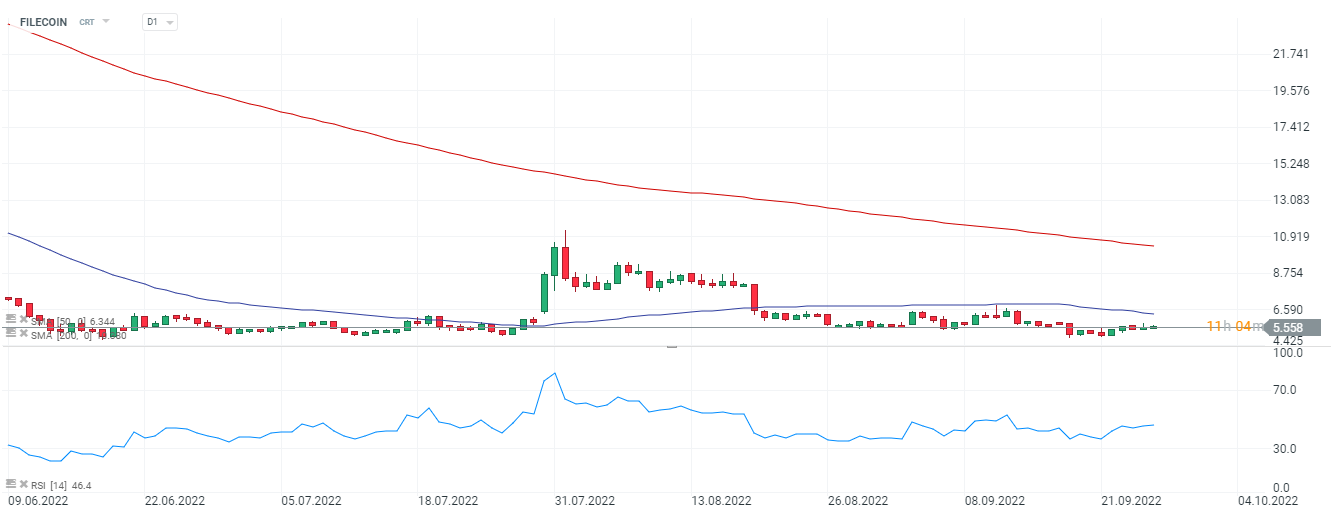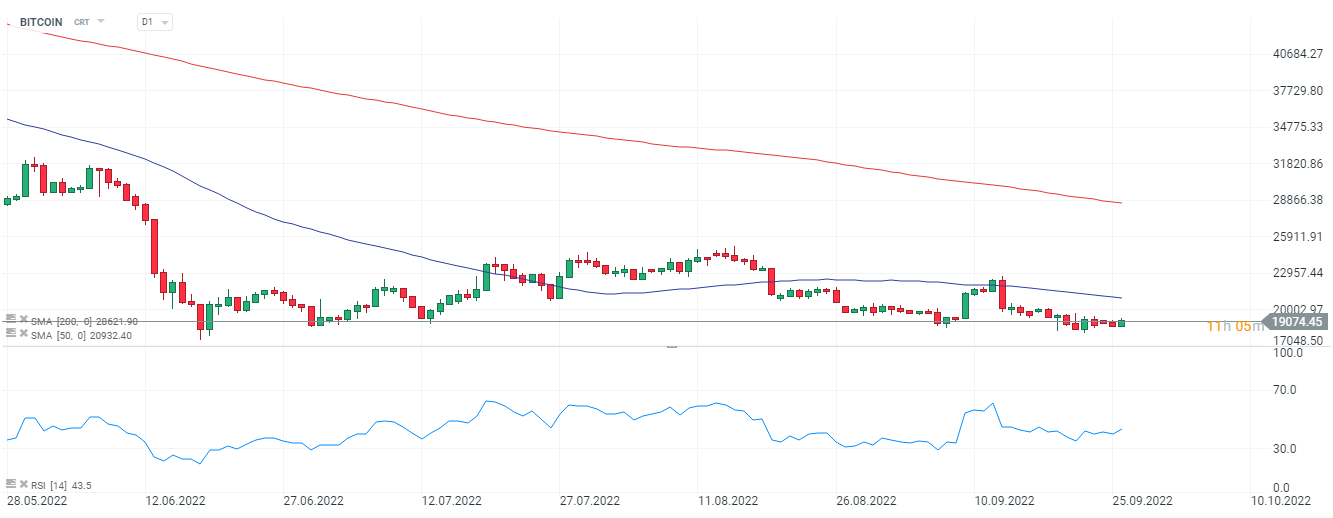Digital assets are starting the week in a mixed mood, with Bitcoin having serious trouble staying above $19,000. Ethereum is trading below $1,300 per token again. In recent months, cryptocurrencies have shown that they do not like to be in a sideways trend for an extended period of time so we can expect an imminent negation of the current consolidation. However, is the cryptocurrency stronghold doomed to another avalanche of supply?
- The supply of new ETH tokens has fallen by 98% since Merge, according to Ultra Sound Money, which confirms that Ethereum is on track to deflate although it is struggling. With network activity still low, Ethereum is still not deflationary (the amount of smoked network fees expressed in ETH by the EIP 1558 algorithm is still low). Since September 15, about 7,500 new ETH have appeared on the network so far, if Ethereum had not undergone a transformation the amount would have been about 130,000 ETH. CEO of Swan Bitcoin, Cory Klippsten pointed out that the merge put a strain on Ethereum because the cryptocurrency lost 'coverage in real mining equipment' as a result, and its valuation became detached from reality resembling more of a 'fantasy abstraction' than a 'hard-covered' financial instrument;
- The World Economic Forum will create the Crypto Sustainability Coalition, an organization to study and analyze the impact of Web3 on decarbonization and halting climate change. Leading cryptocurrencies like Ripple, Stellar, Solana, Avalanche and Near Protocol, among others, have already become members of the movement;
- egulatory bill has already been approved by the state senate and state assembly. Gavin stressed, however, that the regulators' stance was taken prematurely because legislation at the federal level will soon step in, which could undermine the regulators' efforts. California is one of the most involved U.S. states in cryptocurrencies which still has less restrictive cryptocurrency policies than New York State. Gavin intends to seek to foster financial blockchain innovation within the state, and moreover, he also pointed to the tens of millions of dollars in regulatory implementation costs;
- Jeremy Kauffman, CEO of the LBRY projects which provides a decentralized video uploading application, reported on a dispute with the US Securities and Exchange Commission, which accused him of selling unregistered securities. Kauffman stressed that the SEC is taking a very strict approach to the still-unregulated regulations by interpreting them according to the narrative adopted by the regulators. Recall, the dispute with the SEC is led by, among others, Ripple and the cryptocurrency fund Grayscale, the largest Bitcoin holder on the market;
- A number of analysts point to the still-poor gaming environment of the recently popular Web3.0, where the 'play-to-earn' model and the vision of alternative lives in virtual worlds are attracting particular attention. At the same time, the graphical and storytelling infrastructure of current Web3 titles is still decades behind the strongest titles. Virtual worlds like Decentraland have attracted tremendous attention from speculators buying up virtual land but have so far been unable to attract hundreds of thousands of regular players to the platform, which could pose a significant development problem. On the other hand, information coming out of the industry indicates a significant migration of talent from the development community to Web3 projects, which may result in faster progress of 'crypto-gaming'. The most talked-about existing cryptocurrencies currently behind gaming projects with metaverse elements are Decentraland and Sandbox;
- At a conference in Singapore, the developers of Filecoin Protocol Labs pointed to the number of customers interested in accessing the decentralized database growing at a staggering 20% per month, but the price of the cryptocurrency is still nearly 50% below the euphoric levels around $10 in early August.
![]()
The Fear and Greed Index invariably indicates 'Extreme Fear', but the levels are still nearly double the June levels. Source: alternative.me
Start investing today or test a free demo
Create account Try a demo Download mobile app Download mobile app Filecoin chart, D1 interval. The cryptocurrency covered up almost completely the 'growth gap' created in early August when the creators broke the news of a partnership with Harvard University. It can be seen that the RSI is recovering from the drop to the area close to oversold, however, it has not settled to the levels of June this year. If the crypto market halts the declines, covering the gap could prove to be a catalyst for an influx of new demand. Source: xStation5
Filecoin chart, D1 interval. The cryptocurrency covered up almost completely the 'growth gap' created in early August when the creators broke the news of a partnership with Harvard University. It can be seen that the RSI is recovering from the drop to the area close to oversold, however, it has not settled to the levels of June this year. If the crypto market halts the declines, covering the gap could prove to be a catalyst for an influx of new demand. Source: xStation5
 Bitcoin chart, D1 interval. Bitcoin is still moving below the 200- and 50-day moving averages, which are now the main short-term and medium-term resistance for the price. A breakout of the cryptocurrency above $20,000 could be a catalyst for an attempt to attack the area around $21,000, where the SMA50 runs, a defeat of the average could herald an imminent reversal of the downtrend, in the short term. As long as quotes run below $20,000 the supply side still has the upper hand, US index futures point to a lower opening on Wall Street which could further depress crypto market sentiment. Source: xStation5
Bitcoin chart, D1 interval. Bitcoin is still moving below the 200- and 50-day moving averages, which are now the main short-term and medium-term resistance for the price. A breakout of the cryptocurrency above $20,000 could be a catalyst for an attempt to attack the area around $21,000, where the SMA50 runs, a defeat of the average could herald an imminent reversal of the downtrend, in the short term. As long as quotes run below $20,000 the supply side still has the upper hand, US index futures point to a lower opening on Wall Street which could further depress crypto market sentiment. Source: xStation5
This content has been created by XTB S.A. This service is provided by XTB S.A., with its registered office in Warsaw, at Prosta 67, 00-838 Warsaw, Poland, entered in the register of entrepreneurs of the National Court Register (Krajowy Rejestr Sądowy) conducted by District Court for the Capital City of Warsaw, XII Commercial Division of the National Court Register under KRS number 0000217580, REGON number 015803782 and Tax Identification Number (NIP) 527-24-43-955, with the fully paid up share capital in the amount of PLN 5.869.181,75. XTB S.A. conducts brokerage activities on the basis of the license granted by Polish Securities and Exchange Commission on 8th November 2005 No. DDM-M-4021-57-1/2005 and is supervised by Polish Supervision Authority.


